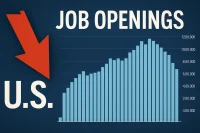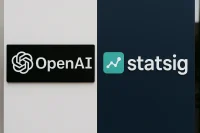The U.S. labor market remains a paradox: jobless claims are ticking up, but layoffs remain modest, and employers are still reluctant to fire. According to new Labor Department data, initial claims rose to 237,000 for the week ending August 30—higher than forecasts. Yet with job openings holding at 7.2 million, most firms appear to be adopting a “no hire, no fire” approach, freezing recruitment rather than slashing jobs.
The numbers suggest a labor market that is cooling without collapsing—a fragile balance watched closely by the Federal Reserve.
Key Data Points
- Jobless claims: 237,000 (up from 232,000 the previous week).
- Continuing claims: 1.85 million, showing more people remain unemployed for longer.
- Job openings: 7.2 million, the lowest since 2018 outside the pandemic.
- Layoffs: Still historically low—firms are holding onto workers despite slower demand.
Employer Mindset: Holding the Line
Many employers fear losing talent permanently:
- Retention Over Risk: Companies burned by 2021–22 shortages are reluctant to let staff go.
- Hiring Freezes Instead: Expansion is paused, but existing workers are being retained.
- Productivity Gains: Employers are leaning on AI and automation to stretch current teams further.
This results in a stagnant job market where workers face fewer opportunities but also fewer pink slips.
Implications for Workers
- Harder to Find New Jobs: With fewer postings, jobseekers face stiffer competition.
- Greater Job Security: For those employed, layoffs remain relatively rare.
- Slower Wage Growth: Employers see less need to raise pay aggressively in a cooling market.
Hold On to the Talent You’ve Got
AI can boost productivity, but people drive loyalty, innovation, and growth. Secure your workforce before the market shifts again.
Post a Job Now →Broader Economic Signals
The uptick in jobless claims adds to evidence of a cooling economy, but it is not yet a sign of collapse. Economists see this as evidence of a “soft landing”—growth slowing without tipping into recession.
The Fed is expected to cut rates soon, using weak job growth and higher claims as justification to ease borrowing costs.
FAQs
Q1: Are jobless claims rising sharply?
Not sharply—claims are creeping higher, signaling gradual cooling, not a sudden jobs crisis.
Q2: Why aren’t layoffs spiking?
Because employers fear repeating past mistakes of cutting too deeply and struggling to rehire later.
Q3: Is this good or bad for workers?
It depends: those employed are safer, but jobseekers face fewer openings and slower wage growth.
Q4: How does this affect the Fed?
It increases the likelihood of rate cuts to stimulate hiring and spending.
Case Study: Amazon Freezes Hiring, Keeps Staff
Amazon, a bellwether employer, illustrates the trend perfectly. In recent months, the company has paused large-scale hiring outside its cloud division but has also resisted significant layoffs after its 2023–24 reductions.
- Corporate hiring is frozen in nonessential areas.
- Warehouse jobs are stable, with minimal layoffs.
- AI tools are being introduced to optimize logistics instead of adding more staff.
This “no hire, no fire” strategy is increasingly common among big firms—holding onto workers while avoiding new commitments.




